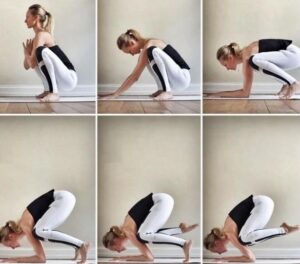“Becoming flexible is not the goal. Standing on your hands is not the goal. The goal is serenity. Balance. Truly finding peace in your own skin.” – Rachel Brathen.
It is a Sanskrit name of Hatha yoga. The yoga begins with squatting and at the final stage, the practitioners place the palms on the ground and lift the body with the entire pressure on the palms. At the final stage, the shape looks like a crow or Kaka (in Sanskrit). Hence, another name of this asana is Crow pose (Fitzabout, 2020). In this crow-like appearance, the hands of the practitioners become the crow’s legs and the legs become the crow’s wings. While practicing this yoga, the practitioners build a good relationship with gravity. The practitioners should maintain proper balance on their palms, by putting the entire pressure of their body on the arms (Śliwa, 2020). The practitioner should hold the position for one to two minutes and breathe normally during the practice of this yoga. The experts can hold the position for up to five minutes.

Benefits of maintaining a good balance!!
In this pose, the practitioners have to rely on their arms and put the entire body pressure on the arms. Thus it helps in strengthening the muscles of the arms, wrist, and stomach muscles, making them stronger (Śliwa, 2020). During this yoga, the practitioners have to focus on their balance, thus it helps in improving their balance and helps them to proceed to perform more complex forms of yoga. The functioning of the internal organs also becomes improved with the regular practice of this yoga. Hence, it improves the digestive system (Śliwa, 2020). Practicing this yoga helps in reducing belly fat. The muscles of the glutes also become strengthened with this yoga. The spine becomes toned and strong with the regular practice of this yoga. After a few practices, the practitioners build a kind of self-confidence within them and they can overcome fear.

Safety and precautions!!
Kakasana is a very complexed yoga. Hence, it should be under the proper guidance of a well-trained yoga instructor. Individuals suffering from any kind of wrist injury should strictly avoid this yoga, as this yoga involves the arms, which carry the entire body weight. Besides, the yoga practitioners suggest that individuals with hip, knees, and shoulder injuries avoid this yoga (Fitzabout, 2020). Individuals suffering from a hernia should become completely healed to practice this yoga. People having vertigo can face difficulties while practicing this yoga, as it involves lifting the entire body. Individuals who have gone through any heart surgeries or brain strokes should strictly avoid this yoga. As it can cause severe injuries to them. Furthermore, the instructors also suggest that individuals suffering from blood pressure-related problems and spondylitis should not perform this yoga.
Beginners may sometimes get bruises on their arms while practicing this yoga, but it will become comfortable after performing on a regular basis (Śliwa, 2020). The beginners are instructed to place a pillow or blanket below their face so that they do not get hurt if they fall by mistake. At first, the practitioners should lift one foot off the floor. This will help them in gaining confidence.
References
Fitzabout. (2020, February). Fitzabout.com. Retrieved from How To Do Baby Crow Pose or Bala Kakasana: https://www.fitzabout.com/yoga/baby-crow-pose-or-bala-kakasana/
Śliwa, M. (2020). What the practice of yoga can do for academic practice: personal reflections. Retrieved from http://repository.essex.ac.uk/29493/8/Sliwa_Essex_Reader_Health_Wellbeing.pdf